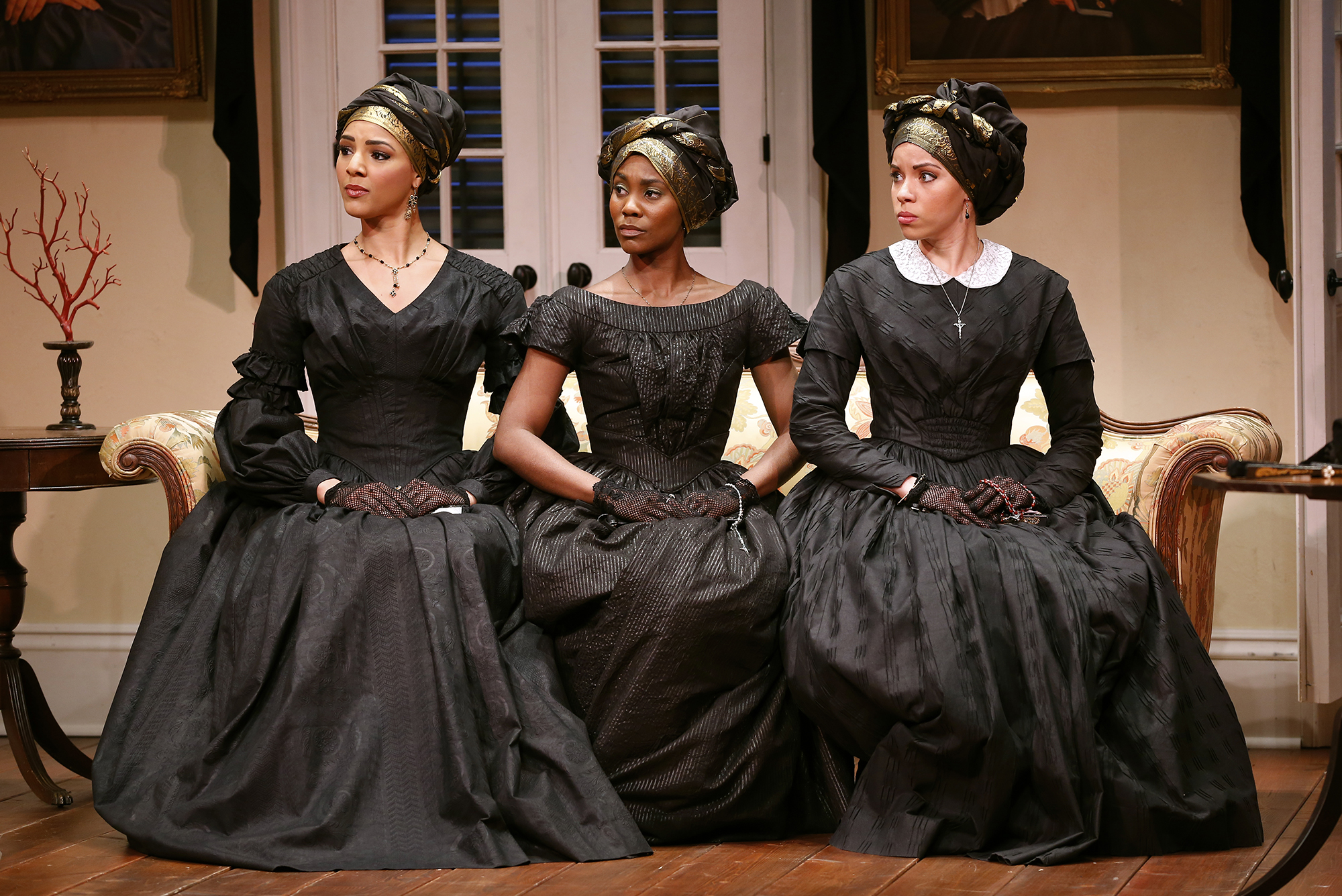Marcus Gardley’s The House That Will Not Stand, now playing at the Yale Rep, directed by Patricia McGregor, runs the audience through a range of emotions as we watch a household divided against itself try to find some common ground. Worked deeply into the texture of the play is a sense of the injustices done to African-Americans and to women in particular, beginning with the transition to “Americans.” Set in New Orleans in 1836, the play takes place about a generation after the Louisiana Purchase gave the U.S. dominion over Louisiana, and that meant that free-born women of color fell considerably in social standing. Gardley’s play treats of the class of women known as placées, who once, though colored mistresses of white men, enjoyed a status closer to equality in the old French New Orleans.

All that is changing with the generation of the young women in the play—Agnès (Tiffany Rachelle Stewart), Maude Lynn (Flor de Liz Perez), Odette (Joniece Abbott-Pratt)—daughters of Beartrice (Lizan Mitchell), a very proud placée whose white paramour, Lazare (Ray Reinhardt) lies in state in the parlor of her house as the play begins. Others in the house are Beartrice’s “crazy” sister Marie Josephine (Petronia Paley) and the strong, sly and eloquent housemaid Makeda (Harriett D. Foy), born a slave and hoping the death of Lazare—and the expected inheritance—will allow Beartrice to buy her freedom, as promised. Meanwhile, Agnès, the eldest daughter, wants nothing more than to become a placée and leave her mother’s house.
The house is key to all this, not only as a structure which the living spirit of the deceased Lazare says he will crush, but in terms of the generations represented by this family. Marie Josephine wants nothing more than to run out to Congo Square and join a perhaps phantasmal drummer who calls for her; likewise, Odette seems likely to run wild if not kept under wraps. And, while Makeda is not above spells and calls to Papa Legba, a god associated with voodoo, Maude Lynn is a fervent Christian who views persecution by her sisters as a Christ-like ordeal. The comedy of the play, broad and lively at the start, creates a sense less of a house divided and more of a house fraught with absurdities.
At the center of the comic elements lies the catty relationship between Beartrice and her neighbor, and former bosom friend, La Veuve (Petronia Paley): the latter had designs on Lazare and now, after his death, has designs on his property. The legal, white wife of Lazare remains resolutely offstage, but La Veuve provides enough of a prickly presence to upset Beartrice’s claims.
Gardley’s busy play gives us set pieces to distinguish each character’s relation to the principle situation—which invites questions of sexual and racial politics. In Beartrice, we see a matriarch who can seem less than sympathetic but whose sense of grievance is great. Lizan Mitchell provides Beartrice with more sand and grit than steel, so that we never forget the shakiness of her status. At times, comic touches—such as her proclamations about her “pie”—seem to misfire as Mitchell is often more shrewish than shrewd. And yet one cannot discount her too easily as her final speech reaches through the ages with a power that puts one in mind of a deposed Lear raining curses. As La Veuve, Paley has the easier role of the grasping and cutting nemesis. Her other role, as Beartrice’s sister who is either mad or more spiritual—in this world, no one is without some belief in the otherworldly—is more amorphous. One senses that Gardley might intend the character to have more gravitas than she finds here.
Among the sisters, Perez comes off best as her role adds outright comedy to the situation; as the one-upping sisters out for a man—the never-seen but longed for Ramon Le Pip—Abbott-Pratt and Stewart never conjure enough mystique to make us choose sides, though Agnès is the more vapid. Both roles seem conveniences more than characters. The play’s strength comes down, ultimately, to Makeda, whose cry for freedom and very knowing view of her “superiors” gives the audience its primary catharsis. Throughout the play Foy’s performance is a focal point, and late in the play her character becomes larger than life and emblematic in a way that makes the climax of The House That Will Not Stand resonate with enough force to bring the house down.
Its mix of tones makes the play worth a second viewing, to grasp better where it’s going and how it gets there. The set (Antje Ellerman) and effects (Russell H. Champa, Lighting; Keith Townsend Obadike, Sound), and especially costumes (Katherine O’Neill), are fine, as ever with shows at Yale Rep, though certain moments, such as the appearance of Lazare’s ghost, lack atmosphere. Lively, vivid, with a host of surprising moments and a sharp eye for the inconsistencies of its time—and ours—on the matters of race, class, and gender, Marcus Gardley’s The House That Will Not Stand is a play that betters its production here, in a show that has traveled from Berkeley Rep, yet McGregor’s production does well at showing us the desperation and delusion beneath the willed charm and vanishing roles of the Old South.
The House That Will Not Stand By Marcus Gardley Directed by Patricia McGregor
Choregrapher: Paloma McGregor; Scenic Designer: Antje Ellermann; Costume Designer: Katherine O’Neill; Lighting Designer: Russell H. Champa; Sound Designer and Original Composition: Keith Townshend Obadike; Vocal Arrangments and Additional Original Composition: Harriet D. Foy; Casting Directors: Tara Rubin, Amy Potozkin; Stage Manager: James Mountcastle
Yale Repertory Theatre April 18-May 10, 2014

